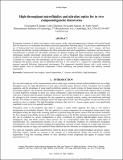| dc.contributor.author | Rohde, Christopher Benjamin | |
| dc.contributor.author | Gilleland, Cody Lee | |
| dc.contributor.author | Samara, Chrysanthi | |
| dc.contributor.author | Yanik, Mehmet Fatih | |
| dc.date.accessioned | 2010-09-15T18:55:16Z | |
| dc.date.available | 2010-09-15T18:55:16Z | |
| dc.date.issued | 2010-02 | |
| dc.date.submitted | 2010-01 | |
| dc.identifier.issn | 0277-786X | |
| dc.identifier.uri | http://hdl.handle.net/1721.1/58554 | |
| dc.description.abstract | Therapeutic treatment of spinal cord injuries, brain trauma, stroke, and neurodegenerative diseases will greatly benefit from the discovery of compounds that enhance neuronal regeneration following injury. We previously demonstrated the use of femtosecond laser microsurgery to induce precise and reproducible neural injury in C. elegans, and have developed microfluidic on-chip technologies that allow automated and rapid manipulation, orientation, and non-invasive immobilization of animals for sub-cellular resolution two-photon imaging and femtosecond-laser nanosurgery. These technologies include microfluidic whole-animal sorters, as well as integrated chips containing multiple addressable incubation chambers for exposure of individual animals to compounds and sub-cellular time-lapse imaging of hundreds of animals on a single chip. Our technologies can be used for a variety of highly sophisticated in vivo high-throughput compound and genetic screens, and we performed the first in vivo screen in C. elegans for compounds enhancing neuronal regrowth following femtosecond microsurgery. The compounds identified interact with a wide variety of cellular targets, such as cytoskeletal components, vesicle trafficking, and protein kinases that enhance neuronal regeneration. | en_US |
| dc.language.iso | en_US | |
| dc.publisher | SPIE | en_US |
| dc.relation.isversionof | http://dx.doi.org/10.1117/12.841748 | en_US |
| dc.rights | Article is made available in accordance with the publisher's policy and may be subject to US copyright law. Please refer to the publisher's site for terms of use. | en_US |
| dc.source | SPIE | en_US |
| dc.subject | Femtosecond | en_US |
| dc.subject | laser surgery | en_US |
| dc.subject | neural regeneration | en_US |
| dc.subject | C. elegans | en_US |
| dc.subject | microfluidics | en_US |
| dc.subject | high-throughput | en_US |
| dc.title | High-throughput Microfluidics and Ultrafast Optics for in Vivo Compound/Genetic Discoveries | en_US |
| dc.type | Article | en_US |
| dc.identifier.citation | Rohde, Christopher B. et al. “High-throughput microfluidics and ultrafast optics for in vivo compound/genetic discoveries.” Imaging, Manipulation, and Analysis of Biomolecules, Cells, and Tissues VIII. Ed. Daniel L. Farkas, Dan V. Nicolau, & Robert C. Leif. San Francisco, California, USA: SPIE, 2010. 75680N-6. ©2010 COPYRIGHT SPIE--The International Society for Optical Engineering. | en_US |
| dc.contributor.department | Massachusetts Institute of Technology. Department of Electrical Engineering and Computer Science | en_US |
| dc.contributor.department | Massachusetts Institute of Technology. Research Laboratory of Electronics | en_US |
| dc.contributor.approver | Yanik, Mehmet Fatih | |
| dc.contributor.mitauthor | Rohde, Christopher Benjamin | |
| dc.contributor.mitauthor | Gilleland, Cody Lee | |
| dc.contributor.mitauthor | Samara, Chrysanthi | |
| dc.contributor.mitauthor | Yanik, Mehmet Fatih | |
| dc.relation.journal | Proceedings of SPIE--the International Society for Optical Engineering; v. 7568 | en_US |
| dc.eprint.version | Final published version | en_US |
| dc.type.uri | http://purl.org/eprint/type/JournalArticle | en_US |
| eprint.status | http://purl.org/eprint/status/PeerReviewed | en_US |
| dspace.orderedauthors | Rohde, Christopher B.; Gilleland, Cody; Samara, Chrysanthi; Yanik, M. Fatih | en |
| dc.identifier.orcid | https://orcid.org/0000-0002-4612-1962 | |
| mit.license | PUBLISHER_POLICY | en_US |
| mit.metadata.status | Complete | |
